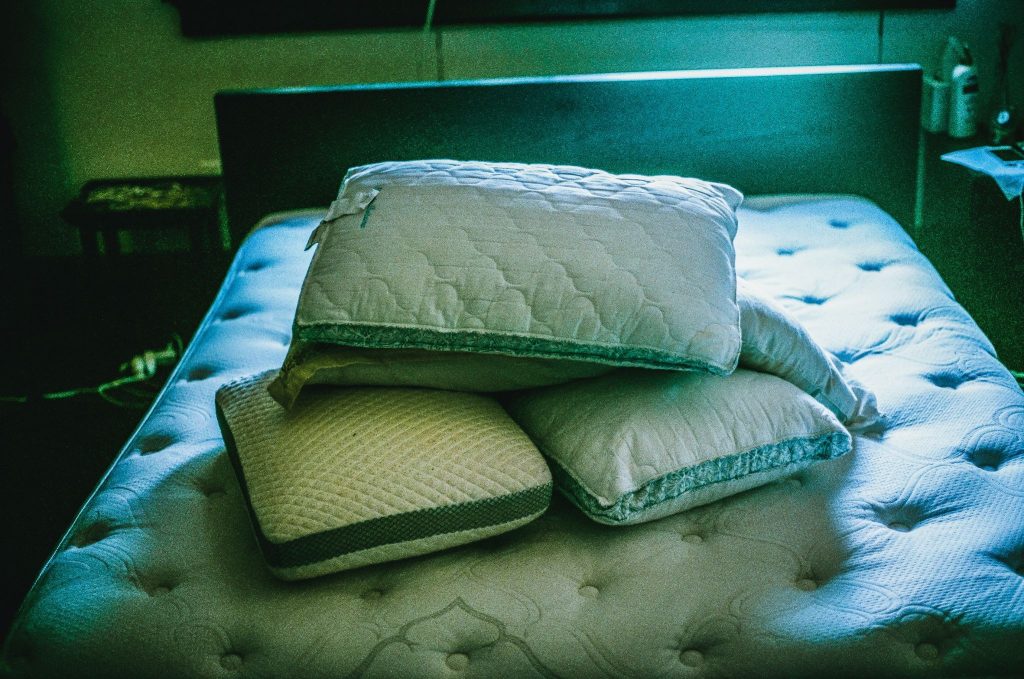
If you love the sinking, cushy feel of a pillow-top but wake up with a sore lower back, you don’t have to choose between comfort and spinal support. A properly constructed pillow-top mattress gives immediate pressure relief at the shoulders and hips while an underlying support core (coils or firmer foam) keeps the spine aligned.
This guide walks through the best pillow-top options for back pain in 2025, what to look for, a comparison table, and an FAQ to help you make a confident choice.
Quick summary — top picks (short)
- Saatva Classic (Pillow Top) — Best overall pillow-top for back pain: luxury construction, zoned support, and multiple firmness options for spinal alignment.
- Nolah Evolution (Pillow Top model) — Best balance of pressure relief and targeted support for back sleepers who prefer plush surface feel with responsive support.
- WinkBed (luxury hybrid with pillow-like euro top) — Best for heavier sleepers and combination sleepers who need zoned coil support plus a plush top layer.
- Naturepedic Concerto Pillow Top — Best organic / natural materials pillow top that still gives solid support for back pain sufferers seeking natural materials.
- Leesa Sapira / Sapira Chill (hybrid with pillow-like comfort layer) — Best for sleepers who overheat on memory foam but want pillow-top style cushioning plus supportive hybrid core.
Why a pillow-top can be good for back pain (short version)

A pillow-top is an extra stitched layer of soft filling sewn to the mattress surface (sometimes as a euro top). Properly designed pillow-tops combine plush surface comfort with a firm or zoned support core underneath. For back pain relief you need two things:
- Pressure relief at shoulders and hips (so tissues don’t compress and create soreness).
- Lumbar support / spinal alignment so pelvis and shoulders stay level — usually delivered by a firmer or zoned support layer below the pillow top.
If the mattress is too soft through the support core, the pillow top becomes a sinkhole; if it’s too firm the pillow top will feel like an uncomfortable topper that doesn’t contour. The best pillow-top mattresses solve both.
Detailed reviews — top pillow-top mattresses for back pain

1. Saatva Classic — Best overall pillow-top for back pain
Why it’s good: Saatva’s pillow-top (the “Luxury Firm / Plush Soft” options and the euro pillow top version) pairs a plush surface with a durable innerspring system that’s zoned to provide more lift under the hips and lumbar area.
Multiple firmness options let you choose a balance that suits your weight and sleep position — critical for keeping the spine neutral. Recovery and long-term durability are frequently praised by testers.
Who it’s for: Back and combination sleepers who want a premium pillow-top feel without sacrificing support.
Not ideal for: People who want the absolute hug of memory foam with deep contouring.
2. Nolah Evolution (Pillow-Top) — Best pressure relief + support balance
Why it’s good: The Nolah Evolution pillow-top models (typically hybrid builds) use a layered comfort system with adaptive foam and pocketed coils that provide rebound and lift. Test labs report excellent pressure relief for shoulders and hips while maintaining lumbar support — a sweet spot for many back pain sufferers who prefer a plush top.
Who it’s for: Side-to-back sleepers who want a plush surface that still supports the mid-lower back.
Not ideal for: Sleepers who require a very firm surface to feel properly supported.
3. WinkBed (Luxury hybrid with euro top) — Best for heavier sleepers & targeted zoning
Why it’s good: WinkBed is a thicker hybrid with strong coil support and zoned design; the pillow-like euro top adds cushioning without reducing the coil’s ability to lift the hips.
Reviewers and sleep labs recommend it for people with chronic back pain because the support core reduces sagging and the top layer reduces pressure points. It also comes in multiple firmness choices.
Who it’s for: Heavier sleepers, stomach/back combination sleepers, and people who need robust edge support.
Not ideal for: Strict side sleepers wanting the deepest hug.
4. Naturepedic Concerto Pillow Top — Best natural / organic pillow top
Why it’s good: This premium organic hybrid uses natural latex, organic cotton, wool, and microcoils under a plush pillow top. Testers note excellent temperature regulation, responsive support, and a plush surface that still maintains spinal alignment for many back sleepers. Great if you want organic certifications plus supportive design.
Who it’s for: Conscious shoppers who want organic materials and reliable support for back pain.
Not ideal for: Budget buyers (priced at the premium end).
5. Leesa Sapira Chill (hybrid) — Best cooling pillow-top hybrid for back pain
Why it’s good: The Sapira Chill blends cooling foam and pocketed coils with a comfort layer engineered to feel like a pillow top (or close to it). It performs well in pressure relief and has responsive lift to support the lumbar region — especially helpful for back sleepers who overheat on classic memory foam.
Who it’s for: Back sleepers who sleep hot and want a pillow-top sensation paired with cooling tech.
Not ideal for: People who prefer innerspring bounce over foam.
Feature checklist — what to look for in a pillow-top mattress for back pain
- Zoned support — firmer in the lumbar area, softer at shoulders/hips. (Key for spinal alignment.)
- Hybrid construction (coil + foam) — coils provide lift and durability; foam layers provide pressure relief. Not a hard rule, but hybrids often perform best for back pain.
- Multiple firmness options — ability to choose medium-firm to firm for many back-pain profiles.
- Durable support core — high-quality pocketed coils or high-density foam to avoid sagging.
- Cooling features — gel, phase-change fabric, natural fibers if you overheat.
- Trial period & warranty — at least 100 nights recommended with robust warranty (10+ years for high-end beds).
Comparison table — at a glance
| Mattress (Pillow-Top style) | Best for | Firmness options | Construction highlights | Price tier |
| Saatva Classic (Pillow Top) | Best overall for back pain | Plush Soft / Luxury Firm / Firm | Euro pillow top + zoned innerspring / dual-coil system | Premium |
| Nolah Evolution (Pillow Top) | Pressure relief + spinal lift | Medium-plush to firm | Adaptive foam layers + pocketed coils | Mid-to-premium |
| WinkBed (Euro top) | Heavier sleepers, zoned support | Multiple (Soft, Luxury Firm, Firm, +Plus) | Zoned pocket coils + plush top | Premium |
| Naturepedic Concerto Pillow Top | Organic materials + support | Medium-plush | Organic latex + microcoils + wool/cotton pillow top | Luxury (organic premium) |
| Leesa Sapira Chill (hybrid comfort) | Cooling + support for back pain | Medium to Medium-Firm | Cooling foam layers + pocketed coils | Mid-premium |
(Notes: “Price tier” is general — look for current sales and regional pricing. See full reviews for exact layering and firmness measurements.)
How to choose the right firmness & model for your sleep position
- Strict back sleepers: Medium-firm to firm with lumbar zoning is ideal. Look for a mattress that supports the lower back (hips lifted to align with shoulders). Saatva Classic and WinkBed are reliable here.
- Back + side (combination) sleepers: A slightly softer pillow-top (medium to medium-firm) that offers pressure relief at shoulders but retains lumbar support — Nolah Evolution is a strong candidate.
- Heavier sleepers (200+ lbs): Choose a mattress with a sturdy coil core and stronger edge support — WinkBed and some Saatva configurations are designed to perform well.
- If you sleep hot: Pick a hybrid with breathable coils and cooling materials (Leesa Sapira Chill, Naturepedic with natural wool) to avoid overheating while retaining pillow-top comfort.
Mattress toppers vs a pillow-top mattress
If your current mattress lacks support, adding a plush topper may feel better short-term but can worsen alignment if the base is too soft. Toppers are best when your mattress is too firm and you need extra cushioning; they’re less helpful if the support core is sagging.
For chronic back pain, upgrading to a mattress with a supportive core plus pillow-top tends to be more effective. For temporary adjustments, choose a high-quality latex or memory foam topper with moderate thickness (1–2 inches for subtle comfort, 3 inches for more contouring) and consider zoned toppers if available.
Care, break-in, and when to replace
- Break-in: Most hybrids and pillow-tops need ~30–90 nights for layers to settle; use the trial period to assess back pain improvement.
- Rotation: Rotate (not flip) every 3–6 months for the first year to even wear — most pillow-tops are one-sided.
- Replace when: sags >1 inch, persistent increase in morning pain, or edge support failure — usually 7–10 years for hybrids (longer for high-end innerspring builds).
Practical tips for buying when you have back pain
- Test on your primary sleep position — during store trials or the trial period, give priority to the position you sleep in most. Trials exist for a reason.
- Check return & trial policies — ensure at least 100-night trial and clear return steps.
- Ask about zoning and coil count — higher coil counts and zoning are usually better for targeted lumbar support.
- Consider split firmness for partners with different needs (some brands offer split-king/adjustable firmness).
- Pair with the right foundation — some pillow-tops benefit from solid foundations, others from slatted/adjustable bases. Manufacturer guidance matters.
Common questions (FAQ)
Q: Are pillow-tops too soft for people with lower-back pain?
A: Not necessarily. A pillow-top is the surface layer; what matters most for back pain is the support core underneath. A well-designed pillow-top mattress combines a plush surface with a firmer, zoned support core to maintain alignment. Look for hybrid constructions and zoning.
Q: Can a pillow-top cause more back pain?
A: If the underlying support is weak (old mattress or low-density foam base), yes — the pillow top can let you sink too far and misalign your spine. Always evaluate the support core and choose a mattress with proven zoned or coil support.
Q: How long will a good pillow-top mattress last?
A: High-quality hybrids and innerspring pillow-tops typically last 7–10+ years with proper care. Organic or latex builds with robust coils can last longer. Warranty and materials matter.
Q: Should I buy a pillow-top if I sleep hot?
A: Yes — choose a hybrid with coils, breathable covers, and cooling foams or natural fibers. Pillow-tops made from natural wool/cotton or those that pair with breathable coil cores will help with temperature control.
Q: Is a pillow-top mattress better than a euro top?
A: “Pillow-top” and “euro top” are similar; euro tops are usually sewn flush to the mattress edge and feel a bit more integrated and streamlined. Both can be built to support the lumbar region — focus on construction and zoning rather than the label.
Final recommendations (how to choose)
- If you want a reliable, well-rounded choice with excellent zoning for back pain: Saatva Classic (pillow top).
- If you want deep pressure relief with responsive support: Nolah Evolution (pillow top models).
- If you are heavier or need very strong support: WinkBed in a firmer configuration.
- If you want organic materials + supportive hybrid: Naturepedic Concerto Pillow Top.
- If you sleep hot and want a pillow-top feel: Leesa Sapira Chill (hybrid).


